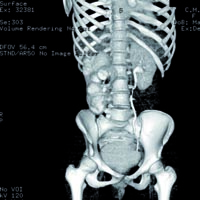Staghorn stone in megapolycalicosis in a child: Still the case for open surgery? Case report

Submitted: 7 March 2020
Accepted: 19 January 2022
Published: 2 February 2022
Accepted: 19 January 2022
Abstract Views: 878
PDF: 381
HTML: 22
HTML: 22
Publisher's note
All claims expressed in this article are solely those of the authors and do not necessarily represent those of their affiliated organizations, or those of the publisher, the editors and the reviewers. Any product that may be evaluated in this article or claim that may be made by its manufacturer is not guaranteed or endorsed by the publisher.
All claims expressed in this article are solely those of the authors and do not necessarily represent those of their affiliated organizations, or those of the publisher, the editors and the reviewers. Any product that may be evaluated in this article or claim that may be made by its manufacturer is not guaranteed or endorsed by the publisher.
Similar Articles
- Carmine Noviello, Mercedes Romano, Letizia Trotta, Giuseppina Rosaria Umano, Alfonso Papparella, Are the complications after laparo-assisted endo-rectal pull-through for Hirschsprung disease related to the change of the anal tone? , La Pediatria Medica e Chirurgica: Vol. 46 No. 1 (2024)
- Mariapina Cerulo, Assunta Turco, Ciro Esposito, Minimally invasive pilonidal sinus disease (PSD) treatment in pediatric patients: A narrative review , La Pediatria Medica e Chirurgica: Vol. 44 No. 1 (2022)
- E. Callus, E. Quadri, A. Compare, A. Tovo, A. Giamberti, M. Chessa, Life Experiences and Coping Strategies in Adults with Congenital Heart Disease , La Pediatria Medica e Chirurgica: Vol. 35 No. 5 (2013)
- Massimo Agosti, Francesco Tandoi, Laura Morlacchi, Angela Bossi, Nutritional and metabolic programming during the first thousand days of life , La Pediatria Medica e Chirurgica: Vol. 39 No. 2 (2017)
- Roberta Barachetti, Elisabetta Villa, Mario Barbarini, Weaning and complementary feeding in preterm infants: management, timing and health outcome , La Pediatria Medica e Chirurgica: Vol. 39 No. 4 (2017)
- Alessandro Calisti, Diaaeldinn Yaseen Salman, Kibreab Belay, Andrea Mombo, Boniphace Tresphory, Giovanni Giuliani, Martina Sertori, Gian Battista Parigi, The hidden burden of Pediatric urology in Sub-Saharan Africa: an analysis of hospital admission data from three East African Health Centres , La Pediatria Medica e Chirurgica: Vol. 46 No. 1 (2024)
- Alessandro Porta, Adriana Avanzini, Marta Bellini, Rosa Maria Crossignani, Stefano Fiocchi, Stefano Martinelli, Luciana Parola, Neonatal gastrointestinal involvement and congenital cytomegalovirus , La Pediatria Medica e Chirurgica: Vol. 38 No. 3 (2016)
- Giovanna Mangili, Elena Garzoli, Youcef Sadou, Feeding dysfunctions and failure to thrive in neonates with congenital heart diseases , La Pediatria Medica e Chirurgica: Vol. 40 No. 1 (2018)
- Gianluca Lista, Fabio Meneghin, Ilia Bresesti, Francesco Cavigioli, Nutritional problems of children with bronchopulmonary dysplasia after hospital discharge , La Pediatria Medica e Chirurgica: Vol. 39 No. 4 (2017)
- G. Piergallini, A. Malerba, L. Mazzucchelli, L. Strohmenger, Generalized aggressive periodontitis in prepubertal age: description and comparison of two cases , La Pediatria Medica e Chirurgica: Vol. 36 No. 4 (2014)
You may also start an advanced similarity search for this article.

 https://doi.org/10.4081/pmc.2022.229
https://doi.org/10.4081/pmc.2022.229




